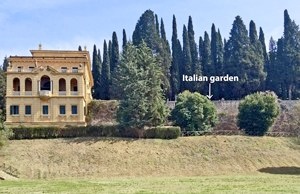
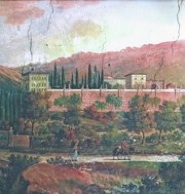
Present Villa Fidelia Villa Fidelia in ca. 1830
Fresco in Palazzo Piermarini, Foligno
Villa Fidelia, which stands below the walls of Spello, now gives its name to a sanctuary here that was monumentalised in an impressive manner in ca. 27 BC. As discussed below, it seems that an earlier sanctuary on this site had belonged to Mevania, and that it had been transferred to Hispellum at about the time of the deduction of the colony here in 41 BC. Many scholars believe that this was the site of an ancient federal sanctuary of the Umbrians, a hypothesis discussed below.
Original Ownership
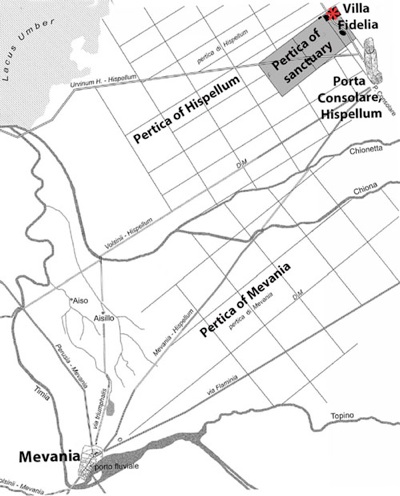
Locus sacer at Villa Fidelia
Adapted from Simone Sisani (referenced below, 2012, Figure 13)
See also, for example, Camerieri and Manconi (referenced below, 2012, Figure 16)
A study of the centuriation of this part of the Valle Umbra by Manconi, Camerieri and Cruciani (referenced below, at pp. 406-9) revealed that Villa Fidelia stands on the northeastern edge of a rectangular ‘island’ of undivided land (illustrated above) that was:
-
✴not aligned with the centuriation of the land immediately surrounding it, which had been divided for the new colony at Hispellum in 41 BC; but rather
-
✴aligned with the older centuriation of Mevania.
This rectangle extended to the southwest, extending some way beyond the area that was monumentalised in the Augustan period (see below). As discussed below, there is some archeological evidence of cult use of this site in the preceding centuries. Simone Sisani (referenced below, 2012, at p. 430) pointed out that:
-
“... the new land division [at Hispellum] ... had evidently preserved and surrounded the undivided land that had previously been assigned to [an] ancient sanctuary. This enclave thus maintained its quality as a locus sacer [sacred place], along with its original orientation, which had been established in a previous programme of centuriation ...” (my translation).
Sisani then drew the following conclusion:
-
“The coherence between [the orientation of the land belonging to] the sanctuary at Villa Fidelia and the centuriation of Mevania obviously indicates that:
-
-the sanctuary had originally belonged to Mevania; and
-
-it was transferred to Hispellum ... only at the moment when the colony was formed” (my translation).
As Sisani pointed out, the centuriation of Mevania occurred, at the latest, at the time of municipalisation (i.e. ca. 90 BC). There is no hard evidence for the ownership of the locus sacer before this time, but the fact that it was left undivided in 41 BC probably reflects a long history as a sacred place: Sisani reasonably assumed that it had probably enjoyed this status in the ownership of Mevania, rather than in the ownership of the less important centre at pre-colonial Hispellum.
Augustan Sanctuary (ca. 25 BC)
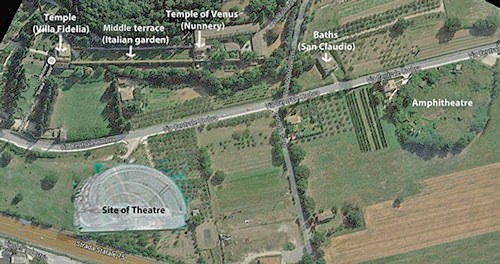
Aerial view of the site of the sanctuary as monumentalised in the Augustan period
The likely plan of the now-demolished theatre is overlaid at the lower left
As noted above, the sanctuary was monumentalised in ca. 27 BC. From that point, it comprised:
-
✴a system of three terraces, with the middle one now forming the Italian garden of Villa Fidelia;
-
✴two main temples, one at each end of this middle terrace:
-
•one temple almost certainly stood at the west end of the terrace, on the site of the present Villa Fidelia (although its existence is largely inferred from the symmetrical arrangement of the site); and
-
•the second temple (securely identified and known to have been dedicated to Venus after colonisation) stood at the east end, on a site that now belongs to the nunnery of the Suore Francescane Piccolo San Damiano;
-
✴a remarkably large theatre that was symmetrically located in relation to these two main temples;
-
✴a thermal complex near the site of the present church of San Claudio; and
-
✴an amphitheatre, slightly further to the east.
I discuss the elements of this monumentalisation below. However, I touch on them here in order to provide a physical context for the discussion of the sanctuary in its earlier incarnations.
Cult Use before 41 BC
Archeological Evidence
The scant archeological evidence for the sanctuary in the period before it passed to Hispellum is known mainly from emergency excavations that were carried out in 1990 at the southwest edge of the site of the Augustan theatre. Fortunately, similar opportunities arose in relation to the Temple of Venus during work on the fabric of the nunnery in 1995-6 and again in 2011. However, with these exceptions, the site remains essentially un-excavated.
Cult Use in the Pre-Roman Period
Manconi, Camerieri and Cruciani (referenced below, p. 391, note 54) recorded the discovery in 1990 of:
-
“... a votive bronze in the form of a hand, typical for Umbrian sanctuaries of 5th and 4th centuries BC, found in the deeper strata [of the excavations]...” ( my translation).
This is the only evidence found so far for cult practices on the site that can be definitely dated to the period before the Roman conquest of Umbria.
Votive Altar of Jupiter (ca. 300 BC)
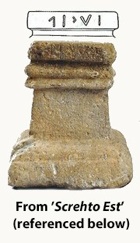
iuvip(atre)
This probably refers to Jove the Father, or Jupiter. [Is it exhibited at the Museo Archeologico at Perugia ??] There is some uncertainty about the date of the inscription:
-
✴Alberto Calderini (in L. Agostiniani, referenced below, entry 27) dated the alphabet used in it to the period between the mid 3rd century and the early 2nd century BC, although he conceded that there was some uncertainty.
-
✴Simone Sisani (referenced below, 2012, at p. 424 and note 86) regarded this as too late, and alternatively dated it to the 4th or 3rd century BC.
Dorica Manconi (also in L. Agostiniani, referenced below, entry 27) asserted that the altar had almost certainly supported a small bronze votive offering to the god, which suggests the presence of a nearby temple of this dedication.
Temple (late 3rd/2nd century BC)
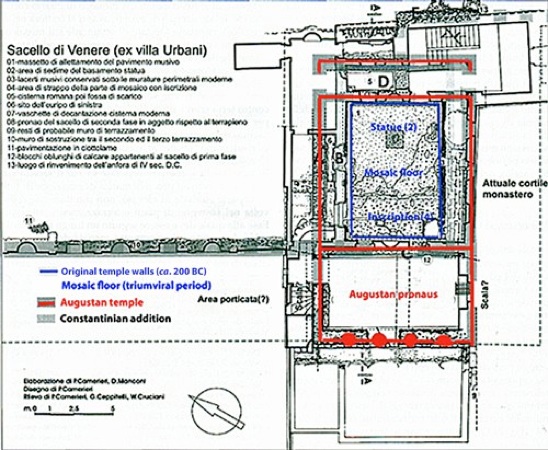
East temple of the sanctuary at Villa Fidelia in the imperial period
Adapted from Camerieri and Manconi (referenced below, 2012, Figure 1)
With kind permission of the authors
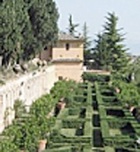
-
✴In the 17th century, during the construction of what was then the Villa Urbani here, the mosaic floor of a temple (marked in blue in the plan above) was discovered and, within it, an inscription from the triumviral period that recorded the donation of a statue of Venus (as discussed below).
-
✴The recent excavations uncovered (inter alia) evidence for a smaller and earlier temple on the site, within the blue boundary above: its pavement had been destroyed when the ‘new’ floor (with its mosaic and inscription) had been installed at a lower level.
Camerieri and Manconi commented that:
-
“[The original construction of the temple] might be ascribed to roughly the period ... of the original urbanisation [of Hispellum] in the late 3rd or 2nd century BC, ... a period that saw the construction of the forum of the city [near Sant’ Andrea] ... in opera quadrata” (my translation).
Architectural Terracottas (2nd-1st century BC)
Manconi, Camerieri and Cruciani (referenced below, at p. 389) recorded that the excavations of 1990 also:
-
“... brought to light architectural terracottas of the 2nd-1st centuries BC, as well as other finds that support the hypothesis of the presence [here] of an ... Italic sanctuary” (my translation).
Unfortunately, these finds were never published, and the information above is all we have (as far as I know).
Interpretation of the Evidence
The interpretation of this evidence is discussed in detail in my page on Bevagna: Sanctuary at Villa Fidelia before 41 BC.
Colonia Julia Hispellum
As noted above, Colonia Julia Hispellum was almost certainly established in 41 BC, when veterans were settled in Italy after the triumvirs’ victory over the assassins of Julius Caesar at Philippi. The analysis of the centuriation of the settled land around the locus sacer at Villa Fidelia (discussed above) suggests that this land was transferred from Mevania to the new colony at this point. As John Scheid (referenced below, 2006, at p. 82) pointed out:
-
“The [sanctuary at Villa Fidelia] was clearly very important [at this time]. But, what interests us more particularly was another decision of Octavian, which [was probably] taken in the same context: he gave the famous sanctuary at the source of the Clitumnus to the Hispellates. ... In other words, he confiscated this cult site from Spoletium, which had owned it since the deduction of the colony [there in 241 BC]; and perhaps he similarly confiscated a supra-regional sanctuary at Villa Fidelia to make a [new] colony and an urban centre” (my translation).
This ‘double’ transfer suggests that both sanctuaries were of considerable significance in 41 BC, and that their transfer was intended to add to the lustre of the new colony by placing it at the heart of the ritual landscape of the Valle Umbra (as discussed further below).
Developments at Villa Fidelia
Triumviral Period
Temple of Venus
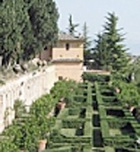
-
✴Durante Dorio and Ludovico Jacobilli, in their‘Memorie e Documenti dell’ Umbria’, noted that:
-
“In the villa of the Urbani family called ‘la Fidelia di Spello’, near the road to Perugia, a large mosaic pavement was found ...” (my translation of the text reproduced by Giovanna Donadoni, referenced below, at note 392).
-
✴Fausto Gentile Donnola noted that:
-
“A mosaic pavement has been found [in Villa Urbani], which I believe was [from Roman] baths, together with a [Roman] inscription in large letters... that is still easily read” (my translation from the text reproduced by Mario and Luigi Sensi, referenced below, p. 101).
Donnola’s transcription allows this inscription to be identified as CIL XI 5264:
M. Granius, Sex. Lollius, IIvir(i)/ quinq(uennales)
signum et basim veneris
ex d(ecreto) d(ecurionum) f(aciunda)
c(uraverunt) eidemq(ue) prob(averunt)
This inscription commemorated the duoviri quinquennales, Marcus Granius and Sextus Lollius, who had commissioned a statue to Venus, following a decree of the decurions of Hispellum. Fausto Gentile Donnola also noted that a nude statue of Venus had been found:
-
“...where the Urbani have their Fidelia, above the theatre, but [it was] in pieces: the head; a foot; an arm with part of the hand ...”, (my translation from the text reproduced by Mario and Luigi Sensi, referenced below, pp. 19-20).
It seems likely that these fragments came from the statue that Marcus Granius and Sextus Lollius had commissioned. The inscription and the fragments of the statue were subsequently lost. However, Donnola’s transcription of the inscription is supplemented by two later records:
-
✴one by Vincenzo Tranquillo, who saw it in the late 16th century in the orchard of the Baglioni family near San Pietro, Perugia (described by Simonetta Stopponi, referenced below, at p. 250, note 129 and illustrated as her Figure 18); and
-
✴one made by Ferdinando Passerini in the 18th century during the work on Villa Fidelia undertaken by the Principessa Teresa Pamphili Grillo (illustrated in Bonacci and Guiducci, referenced below, at p. 173, their Figure 289).
The magisterial office held by Marcus Granius and Sextus Lollius was that of the leading magistrates of the new colony. As noted in my page on Colonia Julia Hispellum, Marcus Granius, who seems to have come from Campania, had probably settled at Hispellum at or soon after colonisation. (Nothing is known, as far as I am aware, of the origins of Sexus Lollius).
As noted above, Paolo Camerieri and Dorica Manconi (referenced below, 2012) published the results of a rapid excavation that was carried out during the restoration of the nunnery in 2011. This revealed a smaller and older temple that corresponded to what they dubbed the first phase of construction on this site, in the late 3rd of 2nd century BC. Its pavement had been destroyed when the ‘new’ floor (with its mosaic and inscription) had been installed at a lower level. Camerieri and Manconi observed (at p. 68) that:
-
“The bi-coloured mosaic, which was located in the new cella and dates to the 2nd half of the 1st century BC, belongs to [Phase II of the construction of the temple]” (my translation).
They identified signs of the base of the new statue at the centre of the cella and evidence that suggested that the inscription had been embedded in the mosaic near its entrance (as indicated in the diagram above).
The commissioning of this statue probably marked the rededication of the old temple: as Camerieri and Manconi pointed out (at p. 69):
-
“Practically by their own admission, the two magistrates reconsecrated a pre-existing [cult site] to a new cult ...” (my translation).
Simone Sisani (referenced below, 2012, at pp. 436-7) asserted that:
-
“[This] represented, above all, the entry into the religious heart of the [Valle Umbra] of the dynastic Caesarian cult of Venus Genetrix, which was central to Octavian’s religious ideology, at least until ... after his victory at Actium ...” (my translation).
Sisani’s observation refers to the fact that Julius Caesar (Octavian’s adoptive and deified father) had claimed Venus as his ancestress. Her cult was consequentially important, not only for Octavian, but also for the veterans of Caesar, some of whom had recently settled at the new colony. In fact, the inscription does not identify the statue as Venus Genetrix, although this does not invalidate Sisani’s point (as discussed further below).
After Actium (31 BC)
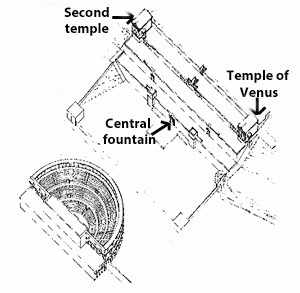
Reconstruction of part of the sanctuary at Villa Fidelia in the imperial period
Adapted from Camerieri and Manconi (referenced below, 2010, Figure 15)
With kind permission of the authors
Simone Sisani (referenced below, 2012, at pp. 435-6) suggested that there was a second wave of veteran settlement at Hispellum after Octavian’s definitive victory over Mark Antony at Actium in 31 BC (as discussed in my page on Colonia Julia Hispellum). This putative second wave of veteran settlement seems to have been associated with significant urban development at Hispellum. According to Paul Fontaine (referenced below, at p. 258-9):
-
✴Porta Consolare, on the decumanus maximus of Hispellum, had probably been built at the time of deduction of the colony, as a formal entrance to its originally unwalled urban centre;
-
✴the long surviving stretches of city walls belonged to a second phase of urban development. He observed that:
-
“An attractive hypothesis is that this second phase was executed at the time of Augustus’ restoration of Via Flaminia in 27 BC” (my translation).
Linda Baiolini (referenced below, at p. 90), who accepted Fontaine’s dating of the city walls, observed that it was supported by the fact that :
-
“... the Porta Venere [which almost certainly marked the start of a processional road from Hispellum to the sanctuary at Villa Fidelia] is indisputably related, not only to the Porta Palatina at Turin (28 BC), but also with the new typology of gates flanked by towers in a series of monuments in the Cisalpina that are generally (but not unanimously) dated to the early Augustan period” (my translation).
The monumentalisation of the sanctuary at Villa Fidelia seems to reflect these two distinct phases of urban development:
-
✴the adaptation of the temple on the site of the nunnery (discussed above) and its rededication to Venus probably occurred during the first phase; while
-
✴the construction of the temple/ theatre complex (illustrated above) coincided with the putative second wave of colonisation.
I describe the elements of this Augustan temple/ theatre complex in the paragraphs below and return to its political significance in the section below entitled ‘Augustan Temple/ Theatre Complex’.
Roman Terraces
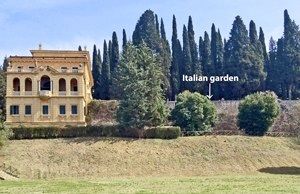
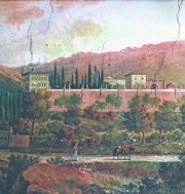
Present Villa Fidelia Villa Fidelia in ca. 1830
Fresco in Palazzo Piermarini, Foligno
Fausto Gentile Donnola recorded the terrace walls of the sanctuary in his ‘Istoria della Terra di Spello’ (ca. 1621):
-
“In the place called Fidelia, there were three walls that can still be seen in part today, one above the other ...” (my translation, from the edition by Mario and Luigi Sensi, referenced below, p. 101).
The remains of these walls can still be seen nearly 400 years later:
-
✴Although the upper terrace no longer survives, a short stretch of the wall that supported it survives to the left of the back wall of ‘Italian garden’ of Villa Fidelia, under the steps that now lead to the grounds above.
-
✴The best-preserved of the surviving terrace walls now supports this Italian garden, which was originally the second terrace of the sanctuary.
-
•Villa Fidelia itself, on the left in the photograph above, was originally built on this second terrace: its projection forward and onto the lower terrace was part of modifications carried out in ca. 1930.
-
•The original Villa Urbani (now the nunnery of the Suore Francescane Piccolo San Damiano) still stands in a symmetrical position at the right of the second terrace (as shown in the fresco above).
-
✴The lower surviving wall had been faced in brick by the time of the fresco (ca. 1830) above.
-
•The left half of the original terrace that it supported subsequently collapsed, and has been replaced by a grassy slope.
-
•However, the right half of the Roman supporting wall survives in the grounds of the nunnery.
Manconi, Camerieri and Cruciani (referenced below, at pp. 384-5) noted that the construction technique used for the terrace walls was the same as that used for the walls of the city itself, which implies that they were built at about the time of the putative second wave of veteran settlement at Hispellum.
Manconi, Camerieri and Cruciani (referenced below, at pp. 387-8) recorded the presence of what had originally been a monumental nymphaeum or ‘fonte lustrale” (source of sacred water) that was precisely at the centre of the lowest terrace, fed by a cistern to the north: according to Paola Bonacci and Sabina Guiducci (referenced below, at p. 169), this cistern was supplied by the ‘acquedotto delle Fontanelle’.
Temple of Venus (again)
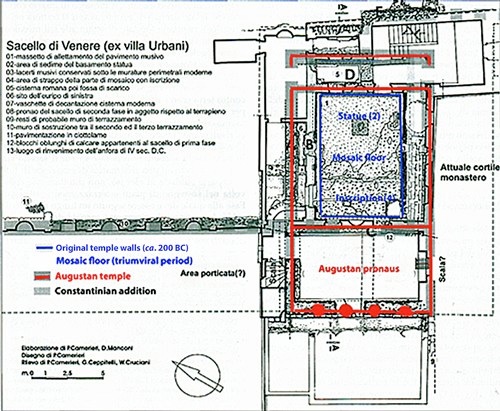
East temple of the sanctuary at Villa Fidelia in the imperial period
Adapted from Camerieri and Manconi (referenced below, 2012, Figure 1)
With kind permission of the authors
Paolo Camerieri and Dorica Manconi (referenced below, 2012, at p. 69) identified a third phase in the construction of the temple on the site of the nunnery (after its modification and rededication to Venus in the triumviral period, as discussed above. This third phase involved the construction of new walls and a new pronaus (marked in red in the plan above). Camerieri and Manconi dated this phase of construction to ca. 27 BC, when Augustus had restored Via Flaminia: in other words, this too broadly coincided with the putative second wave of veteran settlement at Hispellum.
As I noted above, Simone Sisani (referenced below, 2012, at pp. 436-7) pointed out that:
-
“[The rededication of this temple to Venus after colonisation] represented, above all, the entry into the religious heart of the [Valle Umbra] of the dynastic Caesarian cult of Venus Genetrix, which was central to Octavian’s religious ideology, at least until ... after his victory at Actium ...” (my translation).
In fact, the inscription (CIL XI 5264) that implies this rededication in ca. 40 BC does not identify the statue as Venus Genetrix: this does not invalidate Sisani’s suggestion: it certainly seems likely that the Venus at Hispellum would have been recognised as Venus Genetrix. However, I wonder whether the association became more explicit after Octavian’s triple triumph of 29 BC, reflecting the fact that Caesar had dedicated the Temple of Venus Genetrix in Rome on the last day of his quadruple triumph of 46 BC.
Second Temple
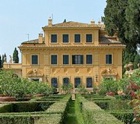
-
“[This putative second temple] must have had architectural characteristics similar to those of the [Temple of Venus], both of which were located about the axis of architectural symmetry passing through the [fountain at the centre of the lowest terrace wall], the axis on which the theatre [below] was also located” (my translation).
Manconi, Camerieri and Cruciani (referenced below, at p. 389, note 48) observed that:
-
“.... from the scaenae frons of the theatre, it was possible to take in with a single glance all the upper part of the sanctuary ... [giving] an easy view of the twin temples without moving the eyes ...” (my translation).
They likened this use of perspective to that in other Hellenistic sanctuaries, which probably reached the ultimate level of refinement in the late 2nd century BC at the sanctuary of Fortuna Primigenia at Praeneste (Palestrina).
Temple of Minerva (?)
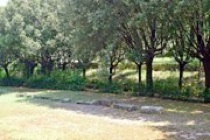
Manconi, Camerieri and Cruciani (referenced below, at p. 390) reported that a large number of blocks and other architectural elements had been excavated at an unknown time beside a well that was located between the Villa Fidelia and the Chiesa Tonda, some 700 meters to the north. They observed that these remains were:
-
“...certainly relevant to the structure of the sacred complex [at Villa Fidelia]” (my translation);
and noted (at note 53) that they had recently been laid out there. Linda Baiolini (referenced below, at p. 117) specified that they were in the ‘galoppatoio’ of Villa Fidelia (as illustrated above), and that they comprised:
-
“... 32 large blocks, half made of white limestone and the other half of travertine, at least four of which shared the same kind of moulding, perhaps belonging to the cornice of a podium” (my translation).
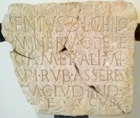
-
“In the convent of the Madonna del Vico, there is a small square stone that was found in 1615, not far from that church [now known as the Chiesa Tonda]” (my translation, from the edition by Mario and Luigi Sensi, referenced below, p. 97).
It is clear from Donnola’s transcription that he referred to CIL XI 5263:
[Ser]venius |(mulieris) l(ibertus) Chilo
aedem Minerv(ae) opere
[tec]t(orio) camera(m) limi[na]
[l]api(de) rub(ro) asseres
...m cludend(am)
f(acienda) cur(avit)
The inscription, which passed to the collection of Ludovico Jacobilli and is now in the Museo Archeologico at Palazzo Trinci, Foligno, records a temple of Minerva that had been [built/ restored] in local ‘pietra rossa’ (pink stone) by Servenius Chilo, the freedman of a lady. The inscription has been variously dated:
-
✴to the late Republican period, before (perhaps only slightly before) the colonisation of Hispellum in 41 BC, by Simone Sisani (referenced below, 2012, at p. 424-5);
-
✴between the late 1st century BC and the early 1st century AD, by Paola Bonacci and Sabina Guiducci (referenced below, at p. 259); and
-
✴27 BC - 14 AD (i.e. during the the reign of Augustus), in the EAGLE database (see the CIL link above).
Paolo Camerieri and Dorica Manconi (referenced below, 2012, at p. 71, note 22) tentatively suggested that:
-
“The use of ‘pietra rossa’ in this temple [as evidenced by CIL XI 5263], as in the Temple of Venus from the Augustan period, and the nearness of the place of recovery of the inscription to [the present Villa Fidelia], suggests that it might be identified as the twin temple on the second terrace there” (my translation).
Linda Baiolini (as above) also suggested that, if one accepts that the blocks in the ‘galoppatoio’ and the inscription came from the same place:
-
“One can ... think that [they are all] related to the temple that is symmetrical with the one that is dedicated to Venus at Villa Fidelia” (my translation).
Thus Camerieri and Manconi, followed by Baiolini, suggest that this second temple might be tentatively identified as the temple of Minerva, which was built/restored by Servenius Chilo at some time in the late Republican or the Augustan period. However, given the uncertainty that surrounds the original locations of both the inscription and the remains in the ‘galoppatoio’, all that can be said with confidence is that they probably related to one or more temples in or near the sanctuary.
Theatre
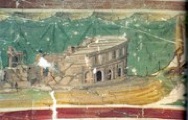
Fresco (16th century) in the Sala degli Zuccari of
Palazzo Comunale Vecchio, Spello
As mentioned above, Fausto Gentile Donnola noted that:
-
“... the Urbani have their [Villa] Fidelia, above the theatre ....” (my translation, from the edition by Mario and Luigi Sensi, referenced below, pp. 19-20).
In another section of this work (at pp. 98-100 in the edition referenced above), Donnola described what seem to have been substantial remains of the theatre near the road to Perugia (now Via Centrale Umbra). Sabina Guiducci (referenced below, at p. 88) noted, the systematic demolition of the theatre began soon after the excavations of 1830, as part of a programme of poor relief.
-
✴All that now remains in situ is the inner core of one of its pilasters, which stands among the trees on the left of the lane opposite San Fedele (below): Manconi, Camerieri and Cruciani (referenced below, at p. 389) recorded that it is partly covered in opera vittata.
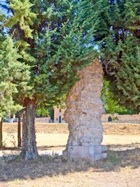
-
✴Fragments of the scaenae frons (the backdrop to the stage) were removed during the excavations of 1830 and are now in the Lapidarium in Palazzo Comunale Vecchio, Spello. According to Paola Bonacci and Sabina Guiducci (referenced below, at p. 237):
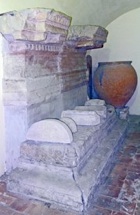
-
“The simplicity and linearity of the style of the cornice allows us to date it to the late Republican or Augustan period” (my translation).
Manconi, Camerieri and Cruciani (referenced below, at p. 389) were able to reconstruct the likely plan of the theatre and its relationship to the terraces and temples discussed above by utilising:
-
✴the fresco illustrated above;
-
✴other archival material from the early 19th century (their Figure 11) and from the excavations of 1830 (their Figure 10); and
-
✴a geophysical examination that was carried out in 1990.
It seems that the theatre was enclosed within a semi-circle, the straight side of which was parallel to and centred on the mid point of the terraces of Villa Fidelia. They therefore deduced that it dated it to the period of monumentalisation of the rest of the sanctuary in the late 1st century BC: in other words, this too broadly coincided with the putative second wave of veteran settlement at Hispellum.
Filippo Coarelli (referenced below, at p. 46) estimated the diameter of the theatre to be 106 meters long and observed that it was :
-
“... the largest in Umbria and among the largest in Italy after Rome” (my translation).
Frank Sear (referenced below, 2006, at pp. 159-64) published a list of the known Roman theatre in the Augustan Regio VI (Umbria): those for which the diameter was known or could be estimated included those at:
-
✴Carsulae (Augustan or Julio-Claudian): 62.7 meters;
-
✴Hipellum (Augustan): ca. 100 meters;
-
✴Iguvium (late Republican): 70.4 meters (capacity 3900 - 4800);
-
✴Mevania (1st century AD): ca. 90 meters;
-
✴Ocriculum (Augustan): 79 meters;
-
✴Spoletium (3rd quarter of the 1st century BC): 72.2 m (capacity 2,800 - 3500); and
-
✴Tuder (ca. 40 BC): ca. 62 meters.
The diameter of the Theatre of Marcellus in Rome, which was probably begun after Actium and which was in use by 17 BC, was ca. 130 meters and it could probably accommodate about 15,000 spectators. Thus, we might reasonably assume that the capacity of the theatre at Hispellum could accommodate about 10,000 people.
Later Developments
The following sections describe the development of the sanctuary that probably took place soon after the construction of the theatre/ temple complex. (Later developments are described in my page on the Sanctuary at Villa Fideliain the 4th Century AD).
Amphitheatre
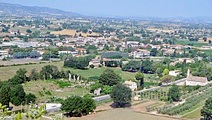
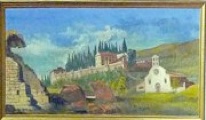
View of the amphitheatre from the Belvedere; Fresco (18th century) of the amphitheatre
The elliptical outline is at the lower left, Sala dell' Editto, Palazzo Comunale Vecchio
with San Claudio to the right Villa Fidelia is depicted at the centre, with
the amphitheatre (left )and San Claudio (right)
According to Sabina Guiducci (referenced below, at p. 83), the amphitheatre opposite San Claudio was recorded in the topographical name ‘Cerchi’ in Spello in the 16th century, and substantial remains were depicted in a sketch map (1715) by Sebastiano Cipriani (which she illustrated). The fresco (18th century) illustrated above also depicts substantial remains. this fresco gives a good impression of the rural aspect of the sanctuary before the building of Via Centrale Umbra, and of the location of the amphitheatre in relation to:
-
✴the twin temples and theatre near Villa Fidelia; and
-
✴the baths near San Claudio (discussed below).
The site seems later to have suffered a similar fate to that documented for the theatre (as described above), although fortunately not quite to the same extent.
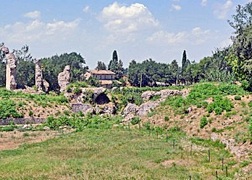
Excavated area of the amphitheatre
from the viewing platform beside Via Centrale Umbra
According to Gian Luca Gregori (referenced below, at p. 968), excavations carried out in 1958-9 brought to light remains of the elliptical structure, which was built with limestone blocks that were laid over a core of opus caementicium (blocks secured by mortar). The specific elements discovered included the podium, part of the ambulacrum (the corridor around the periphery) and some of the passages that led into the arena. According to Mario Brozzi (referenced below, at p. 32) the arena measured 59.2 x 35.5 meters along its axes, and could hold 15,000 spectators in two tiers. However, the capacity figure should probably be treated with caution: Jean-Paul Thuillier (referenced below) pointed out that the amphitheatre at Volsinii was of comparable size (58.65 x 42.15 meters), but he estimated its capacity at only 7,000 spectators.
A fragmentary inscription (AE 1988, 0517, 27BC - 14 AD) on marble that was found during the excavations of 1958-9, reads:
. . .IVS ... / COLONIAE HIS[PELLI] . . . / PECVNIA SV[A] ....
This inscription, which is illustrated in Lacuscurtius, was initially moved to San Claudio but was removed for restoration after the earthquake of 1997 and is now in the deposit of the Soprintendenza per i Beni Archeologici dell'Umbria. Gian Luca Gregori (referenced below, 1984, at p. 962) reasonably assumed that it commemorated the construction of the amphitheatre in which it was found. He also pointed out that the letter before ‘IVS’ in the top line was either a ‘P’, a ‘T’ or an ‘F’. He suggested that the last of these was the most likely, on the basis of the equally impressive inscription (CIL XI 5278) from the tomb of the gens Alfia, which is now embedded in the facade of San Lorenzo: it commemorates (inter alia) Caius Alfius Rufus, a member of the Lemonia tribe, who was duovir quinquennalis of the Colonia lulia Hispellum after having held that post in his native Casinum. On this basis, the EAGLE database completes the inscription from the amphitheatre as:
[C(aius) Al]fius [C(ai) f(ilius) Lem(onia) Rufus, IIvir quinq(uennalis)?]
coloniae His[pelli et IIvir quinq(uennalis) in municipio Casini?]
pecunia su[a faciundum curavit et dedicavit?]
I argue below that the construction of the theatre-temple part of the complex was probably financed by Augustus. However, it seems that the amphitheatre was financed by a private individual, quite possibly Caius Alfius Rufus.
Although Gregori declined to date the amphitheatre itself on the basis of its surviving remains, he dated the inscription recording its construction to the Augustan period (27 BC - 14 AD). (This is followed in the EAGLE database - see the AE/CIL links above). According to Manconi, Camerieri and Cruciani (referenced below, at p. 390):
-
“... the construction technique [used for the amphitheatre] appears to be slightly later than that of the sanctuary terraces, although the similarity of typological and dimensional features, such as:
-
-the angle used in the ‘cunei’ (the wedge-shaped divisions of the seating, defined by radiating stepped aisles); and
-
-the architectural form of the pillars;
-
suggest a unified planning stage with that of the theatre”, (my translation).
If I have understood this correctly, the suggestion is that the two structures were part of a single plan, but the construction technique used for that amphitheatre suggests that its actual construction post-dated that of the theatre.
Luigi Sensi (referenced below, 1987, pp. 8-9, entry 4) recorded a fragmentary inscription (AE 1988, 0514) on a marble block that was also in San Claudio (now in the deposit of the Soprintendenza per i Beni Archeologici dell'Umbria). We might reasonably assume that this too came from the amphitheatre. The inscription had been defaced, but Sensi deciphered its central part:
... M ...
... T X IMP X ...
... RPETUO P ...
... DEC DECR ...
The last line clearly indicates that the decuriones (local councillors) had decreed a dedication to someone, presumably someone of importance.
-
✴The second line almost certainly identified the year as that in which the dedicatee had held imperium and tribunician power for the tenth time.
-
✴Sensi completed the third line as ‘censor perpetuus, patri patriae’
The post ‘censor perpetuus’ identifies the dedicatee as the Emperor Domitian, the only emperor to hold this title (from 83 AD until his murder in 96 AD); his subsequent damnatio memoriae presumably explains the apparently deliberate defacement of the inscription. Thus, it is possible that the amphitheatre was rebuilt or substantially restored in 90 AD, the probable year in which Domitian held imperium and tribunician power for the tenth time. (This dating is given in the EAGLE database, together with a full completion of the inscription - see the AE link above.)
Baths
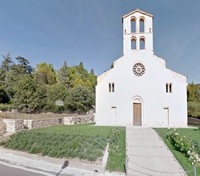
Church of San Claudio, Spello
Excavations in 2001-3 on the site of San Claudio brought to light the remains of the baths on the left side of the church. The finds included a wall in opus caementicium, and also fragments of terracotta piping and part of a pink and white mosaic floor (illustrated in Paola Bonacci and Sabina Guiducci, referenced below, at p. 162, Figure 268). There is an interesting display of the relating to these excavations in the grounds of the church.
Augustan Temple/ Theatre Complex
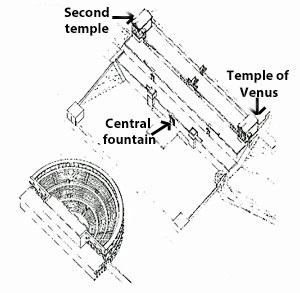
Reconstruction of part of the sanctuary at Villa Fidelia in the imperial period
Adapted from Camerieri and Manconi (referenced below, 2010, Figure 15)
With kind permission of the authors
Filippo Coarelli (referenced below, 2001, at p. 46) was perhaps the first person to underline the significance of this complex:
-
“We are dealing with the largest complex of its kind known in central Italy, more extensive than the large sanctuary of Fortuna Primigenia at Praeneste and that of Hercules Victor at Tivoli. ... [Particularly] of note are the exceptional dimensions of the theatre, the largest in Umbria, and among the largest in Italy outside Rome. ... The exceptional size of the sanctuary and [its suburban position] allow us to consider it to be a structure completely autonomous and self-sufficient in relation to the city [of Hispellum]” (my translation).
Although (as noted above) the sanctuary subsequently acquired an amphitheatre and baths, this magnificent Hellenistic theatre/ temple remained its distinguishing feature.
Evidence of an Antiquarian Project ?
Theatre
Filippo Coarelli (referenced below. 2001, at p. 47) suggested that:
-
“The dimensions of the theatre [at Villa Fidelia, which would have been] excessive for a small city like Hispellum, can be perfectly explained if it was intended for use by the whole nomen Umbro. We are [of course] dealing with an Augustan complex ... [However], from the [archeological] indications found to date [discussed above], which are scant but secure, it seems evident that the sanctuary [in its Augustan form] represented the monumentalisation of a much older structure. ... This monumentalisation ... is therefore one of many examples in the antiquarian Italian tradition, typical of the ideology of Augustus. An intervention on this scale would not have been justifiable if we were dealing with a local cult: we must be dealing with the ethnic sanctuary of the Umbrians” (my translation).
This hypothesis is supported to some extent by the evidence of the so-called Rescript of Constantine (ca. 335 AD), which (as discussed below) indicates that the theatre was probably used from that time for the theatrical shows that formed part of an annual festival that was presided over by “a priest provided by Umbria”. Filippo Coarelli (referenced below, 2001, at p. 43) argued that:
-
“... in the absence of proof to the contrary, the citation of ‘Umbria’ and ‘Tuscia’ [in the Rescript] without any other indication seems to refer to the respective territories in their totality: i.e. to the Augustan regions VI and VII” (my translation).
In other words, in Coarelli’s view, Augustus had rebuilt the sanctuary at Villa Fidelia on a grand scale in order to reflect and celebrate its putative rôle as the ancient federal sanctuary of the Umbrians. He intended that it should once again be used by “the whole nomen Umbro”, the descendants of the tribes who had used the putative pre-Roman “ethnic sanctuary of the Umbrians” here. On this model, the putative Umbrian Federation of the pre-Roman period had been revived, albeit as a purely socio/religious organisation, with the newly-monumentalised ethnic sanctuary at its heart. For Coarelli, by ca. 335 AD, the theatre served the people of all the municipia of Regio VI, which extended across much of modern Umbria (excluding Perugia and Orvieto) and also across the Apennines to the Adriatic coast.
I have the following specific problems with this hypothesis:
-
✴Coarelli asserted (at p. 47) that:
-
“An intervention on this scale would not have been justifiable if we were dealing with a local cult: we must be dealing with the ethnic sanctuary of the Umbrians” (my translation and my italics).
-
This ‘must’ is surely too strong: in the following section, I suggest other reasons why the theatre at Hispellum might have been designed to serve Hispellum itself and some of its neighbouring municipia.
-
✴While Coarelli might be correct in asserting (at p. 43) that ‘Umbria’ in the Rescript of ca. 335 AD referred to the cities of the Augustan Regio VI (which had been combined with those of Regio VII by this time to form the province of Tuscia et Umbria), we cannot rule out alternative definitions (as he acknowledges in the careful wording of this passage).
More fundamentally, I think that the reasoning that underpins the hypothesis over-emphasises the significance of the relative size of the theatre at Hispellum: it is true that its capacity was probably two or three times that of those of municipia such as Spoletium or Iguvium (as set out above), but this does not mean that it must have been designed for the use of “the whole nomen Umbro” (whatever that meant in ca. 27 BC).
Via Triumphalis
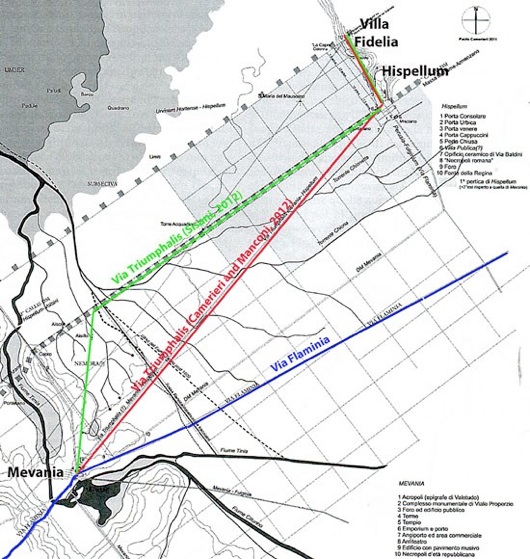
Possible route of the via triumphalis mentioned in CIL XI 5041
Adapted from Camerieri and Manconi (referenced below, 2012, Figure 17)
(The route in green is as proposed by Simone Sisani (referenced below, 2012, Figure 13)
As discussed in my page on Valetudo and the Magistri / Novemviri Valetudinis, an inscription (CIL XI 5041) in the Museo Archeologico of Bevagna records the paving (or re-paving) of a road called the via triumphalis (triumphal way) using stone from Hispellum. Only the lower part of the inscription survives, but it is almost certain that the project was financed by the magistri/ novemviri Valetudinis (a magistracy unique to Mevania but probably similar in many ways to the seviri and seviri Augustales of other municipia). According to Carlo Pietrangeli (referenced below, at pp. 58-9), this inscription was discovered under the street leading to the facade of the church of San Francesco in Bevagna (marked at the lower left in the plan above). There is some uncertainty as to its date:
-
✴Simone Sisani (referenced below, 2012, at p. 416) dated it on paleographic grounds to the “primissima età imperiale” (i.e. to ca. 27 BC). If this is correct, then the paving of the via triumphalis would have have broadly coincided with the monumentalisation of the sanctuary at Villa Fidelia.
-
✴The EAGLE database (see the CIL link above) gives a later date, in the first three decades of the 1st century AD.
Simone Sisani (referenced below, 2002, at p. 496) asserted that:
-
“The ritual nature of [via triumphalis at Mevania] is clear from its name: this is a unique parallel to the [via triumphalis] in Rome, which was associated with the [Roman] victories over the Etruscan city of Veii [in the 4th century BC] and with the archaic triumph. In the light of what we know about the oldest ‘Latin’ triumph, which had as its destination the federal sanctuary of Monte Albano, the [original] via triumphalis of Mevania can be identified with the road that linked Mevania, perhaps the political capital of the [putative pre-Roman Umbrian] League, to the [putative pre-Roman ] federal sanctuary that was located at nearby Hispellum” (my translation).
Filippo Coarelli (referenced below, 2001, at p. 48), who cited this paper by Sisani, reached broadly the same conclusion:
-
“[The via triumphalis at Mevania is] the only example of this denomination that we know outside Rome. The route of the triumph at Rome started at the sanctuary of Sant’ Omobono (the site of the temples of Fortuna and Mater Matuta) and ended at the temple of Jupiter on the Capitol. In the case [of Mevania], the point of departure was probably a temple of Valetudo - probably a Roman interpretation of an Umbrian deity of virtus (bravery and military strength) as well as sanatio (healing) - while the point of arrival was at the sanctuary at Villa Fidelia, dedicated to Jupiter and Venus. The model, for both Rome and Mevania, was probably the sanctuary of the fanum Voltumnae at Volsinii, the centre of the Etruscan League and dedicated to the cult of (Tinia) Veltumna, the principal god of the Etruscans [probably an Etruscan form of Jupiter]” (my translation).
Consistent with the theory (above) that the sanctuary at Villa Fidelia had long had a triumphal function, analogous with that of:
-
✴the sanctuary on Monte Albano (Sisani); and
-
✴those on the Capitol in Rome and at the fanum Voltumnae at Volsinii (Coarelli);
these scholars suggested that, like these other sanctuaries, it was dedicated to Jupiter: this was supported by the votive altar inscribed ‘iuvip(atre)’ that was discussed above. Thus:
-
✴Filippo Coarelli (referenced below, 2001, at p. 48) asserted that the point of arrival of the via triumphalis from Mevania:
-
“ .... was at the sanctuary at Villa Fidelia, dedicated to Jupiter and Venus” (my translation).
-
✴Simone Sisani (referenced below, 2012, at p. 437) asserted that:
-
“... the main temple [of the Augustan complex], probably dedicated to Iuppiter, which [scholars have tried] in vain to trace on the upper terrace, ... in my opinion should be sought below, in the vast area behind the theatre, at the centre of the whole complex and in an emphatic position... “ (my translation).
On the basis of this analysis and of archeological evidence from Bevagna, Simone Sisani (referenced below, 2012, at pp. 417-8) deduced that the road paved by the magistri/ novemviri Valetudinis followed the route shown in red in the plan above.
In other words, according to both Sisani and Coarelli, the magistri/ novemviri Valetudinis paved an ancient road that was still remembered in the Augustan period as the route used for triumphal processions in the pre-Roman period. :
-
✴The ancient processions had started at the putative federal capital at Mevania and ended at a temple dedicated to Jupiter in the putative federal sanctuary.
-
✴This ritual was revived in the Augustan period, still starting at Mevania and ending at the sanctuary at Villa Fidelia. Depending on the date given to the inscription, the paving or re-paving of the processional route took place either at the time of the Augustan monumentalisation of the sanctuary or alternatively some decades later. The revival of the ritual was reflected in the revival of the ancient sanctuary, which retained its original dedication after its Augustan monumentalisation.
Neither Coarelli nor Sisani specifically addressed the context in which these Augustan processions took place: presumably they formed part of ritual celebrations of the victories and triumphs secured under Augustus.
I agree that the via triumphalis was probably a processional route from Mevania to the sanctuary at Villa Fidelia. However, I doubt that it had anything to do with ancient Umbrian triumphal ritual, not least because (as far as I am aware) there is no hard evidence that such a ritual ever existed. Nor is there any evidence for a temple in the Augustan sanctuary that was dedicated to Jupiter. More fundamentally, following the victories of Augustus (the still Octavian) at Actium and in Egypt and his triple triumph of 29 BC, it is entirely possible that a via triumphalis was so-designated to reflect the euphoric political climate of the times: the veterans and other supporters of Augusts who now provided the leading men of the municipia of the Valle Umbra, many of whom were from places outside Umbria, would surely not have needed memories of ancient Umbrian ritual to inspire them to create a processional route that would be used in celebrations of the triumphs and victories of Augustus.
Example of the Revived Etruscan Federation
Filippo Coarelli (referenced below, 2001, at p. 49) saw a parallel with the putative revival of the pre-Roman Umbrian Federation and its rituals in the Augustan period on the one hand and the more securely documented Augustan revival of the pre-Roman Etruscan Federation on the other:
-
“We can construct with high probability the existence of an Umbrian federal centre, located between Mevania and Hispellum, based on the model of the fanum Voltumnae at Volsinii [the federal sanctuary of the Etruscans in the pre-Roman period]. This [Etruscan] sanctuary also knew ... an antiquarian restoration in the Augustan period, which is known to us from the epigraphic evidence for the praetores Etruriae quindecim popularum [priests of a revived federation of 15 Etruscan peoples] in the imperial period]” (my translation).
It is certainly true that existence of a revived Etruscan Federation in the Augustan period is securely attested: see, for example, the paper by Marco Ricci, referenced below. However, I doubt that this throws much light on the motivation for the design of the Augustan theatre/ temple complex at Villa Fidelia:
-
✴There is no surviving evidence for the location of the meeting place of the revived Etruscan Federation. It might have met at the sanctuary at fanum Voltumnae at Volsinii, but the location of this sanctuary is still a matter for debate. Some scholars locate it at the Campo della Fiera, below Orvieto, which was certainly the site of an ancient and extensive sanctuary from perhaps the 6th century BC. A small temple that still survived on this site win the Augustan period was restored at this time, but there is no evidence for a programme of monumentalisation here on the scale of that carried out at Villa Fidelia. Thus, I can see no basis for Coarelli’s assertion that:
-
“... the fanum Voltumnae at Volsinii [, like the sanctuary at Villa Fidelia,] ... also knew ... an antiquarian restoration in the Augustan period ... ”
-
✴Furthermore, there is no surviving evidence for the existence of the revived Etruscan Federation at the time of the construction of the theatre/ temple complex at Villa Fidelia (i.e. in ca. 27 BC): earliest surviving epigraphic evidence for a praetor Etruriae (Sextus Valerius Proculus, who is commemorated in CIL XI 7979 and AE 1996, 653b from Bettona) dates to the early 1st century AD, when the political climate was very different.
My Conclusions
I doubt that thoughts of antiquarian restoration were foremost in Augustus’ mind in ca, 27 BC. It seems to me that the motivation for the construction of the Augustan theatre/ temple complex, which clearly was designed for pan-municipal use, is more probably related to the extraordinary political climate ofter Octavian’s victories at Actium (31 BC) and at Alexandria (30 BC), which brought an end to decades of civil war.
An Augustan ‘Triumphal’ Project ?
Political Climate
As I discussed in my page on Colonia Julia Hispellum, in 29 BC, the victorious Octavian (soon to be named Augustus) celebrated the triple triumph that marked of the end of decades of civil war: he was now the undisputed ruler of the Empire, and his victories had unlocked the wealth of Egypt for the reconstruction of Italy. As noted above, Hispellum almost certainly witnessed a second wave of veteran settlement at this time, involving many of the heroes of Actium. Importantly, funds and public land were now available for the purpose, so the brutal land confiscations that had characterised the original deduction of the colony could be avoided. As elsewhere in Italy, the people of the Valle Umbria could start to rebuild their lives within a local society that had been transformed by immigration. Meanwhile, Augustus could concentrate on establishing a new public persona, particularly here, where the horrors of the Perusine War of 41-40 BC could hardly have been forgotten.
In 27 BC, Augustus financed the restoration of the Via Flaminia, one branch of which ran through Mevania and continued through land that probably belonged to Hispellum. However, this was not the only major construction project in the Valle Umbra at this time: in addition, the urban centre of Hispellum received its first circuit of walls. Paul Fontaine (referenced below, at p. 260-1) observed that the function of these walls seems to have been to underline the importance of the colony: they certainly were not needed for defence! He pointed out that they:
-
“... have the appearance of a prestige project with an essentially symbolic meaning ... [The] concept that sees the walls and the city as an autonomous entity is profoundly rooted in the Roman mentality: more than one text testifies to it, and one finds an excellent illustration in the case of Hispellum, where the walls symbolise the colony [itself]” (my translation).
Thus the walls were meant to demonstrate the high status of the colony, quite possibly because it was in the process of expansion in order to accommodate some of the men who had triumphed at Actium. He also observed that, since inscriptions at Fano and Nîmes, attest to the fact that their walls were built by Augustus:
-
“... we might ask ourselves whether the walls of Spello were not a manifestation of imperial euergetism. Their refined construction presupposes the expenditure of considerable financial resources, and Augustus’ [earlier] gift to the [colony] of the sanctuary of Clitumnus is indicative of his special solicitude towards it” (my translation).
This does not, of course, provide hard evidence of imperial involvement in the construction of the walls. However, it seems to me that Fontaine is probably correct, and that, like the restoration of Via Flaminia, the building of these walls was probably an imperial project.
As noted above:
-
✴the new city walls included the magnificent Porta Venere, at the start of what was almost certainly the processional route leading to the sanctuary; and
-
✴at least two elements of the Augustan theatre/ temple complex - the construction terrace walls and the rebuilding of the Temple of Venus - were certainly carried out at the same time, using similar construction techniques.
It therefore seems to me that we should probably see the construction of this complex as part of a single imperial project aimed at placing the expanded colony at the heart of the political and religious life of the Valle Umbra. As noted above, the complex seems to have been designed for pan-municipal use, presumably as a locus for the joint cult practices held at regular intervals. These would have been largely financed by the local élites, which were now made up of:
-
✴newly settled veterans belonging to the colony of Hispellum who had held senior military commands under Caesar and Octavian;
-
✴other recent viritane settlers who prospered in the neighbouring municipia in the new economic circumstances; and
-
✴members of the original municipal élites, most of whom presumably owed their survival to their support for Octavian during the Perusine War (41-40 BC).
Via Triumphalis (again)
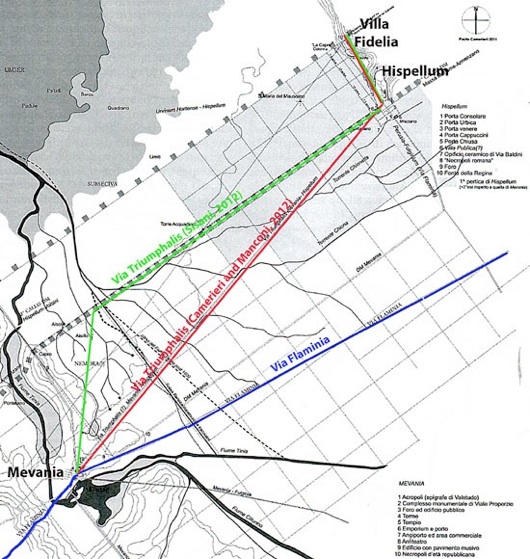
Possible route of the via triumphalis mentioned in CIL XI 5041
Adapted from Camerieri and Manconi (referenced below, 2012, Figure 17)
(The route in green is as proposed by Simone Sisani (referenced below, 2012, Figure 13)
In this section, I continue the discussion of the significance of the via triumphalis, the paving or repaving of which by the magistri/ novemviri Valetudo of Mevania is evidenced by the inscription (CIL XI 5041), perhaps at the time of the construction of the theatre/ temple complex or perhaps a few decades later. As I discussed above, I agree with those scholars such as Filippo Coarelli and Simone Sisani who see this as a processional route from Mevania to the sanctuary at Villa Fidelia. However, I doubt that it had anything to do with ancient Umbrian triumphal ritual, not least because (as far as I am aware) there is no hard evidence that such a ritual ever existed. I think that this road probably received its name because it was used in the ritual celebrations of the triumphs and victories secured for Rome under Augustus.
Augustus and Triumphal Ritual
Triumphal ritual played a central role in Augustus’ self-projection. As Frances Hickson (referenced below, at p. 124) pointed out:
-
“As princeps,... Augustus manipulated political ceremonies and exploited visual media in such a way as to monopolise, for himself and his intended successor, the image of triumphator. Paradoxically, one of the means toward this end was the avoidance of triumphal processions. After his magnificent triple triumph after Actium in 29 BC, Augustus [himself] refused to celebrate additional triumphs.”
She pointed out (at p. 137) that this was probably because, in the Republican period, all of the men who had celebrated more than three triumphs had been dictators. (In particular, Augusts’ ‘father’, Julius Caesar, had been assassinated only 18 months after his quadruple triumph of 46 BC.) Nevertheless, as Augustus recorded in his biography:
-
“The Senate, on 55 occasions, decreed that thanks should be rendered to the immortal gods for successful operations on land and sea that had been conducted either by myself or by my lieutenants under my auspices. The days on which such thanks were rendered by decree of the Senate numbered 890” (‘Res Gestae Divi Augusti’, 1:4).
Augustus was clearly referring here to ceremonies of thanksgiving at Rome, but it seems likely (at least to me) that many of these would have been mirrored in other cities across the Empire, and particularly at Augustan colonies like Hispellum. In that case, we might reasonably assume that people arriving at such celebrations from the south along Via Flaminia, turned left along a processional route that had been established for the purpose.
Via Flaminia
As discussed in my page on Colonia Julia Hispellum and touched on above, Augustus financed the restoration the Via Flaminia in 27 BC, probably from the spoils of war. According to Cassius Dio:
-
“[Via Flaminia] was finished promptly ... and statues of Augustus were accordingly erected on arches on [the Milvian Bridge, outside Rome] and at Ariminum”, (‘Roman History’, 53:22).
Carsten Hjort Lange (referenced below, at pp. 161-2 and note 46) cited coins that suggest that these were:
-
“ ... ‘triumphal arches’, in as much as they were connected to triumphs, even if their purpose was to honour Augustus for road building. ... [They] operated as triumphal markers in Rome and Italy, glorifying the victory at Actium.”
Frances Hickson (referenced below, at p. 134) made a similar point:
-
“Both the repair [of Via Flaminia] and the arches [at its ends] were part of a republican tradition by which many triumphatores built or restored public buildings and works in fulfilment of vows and as a means of memorialising their victories.”
It seems likely that the stretches of the restored Via Flaminia in the Valle Umbra were similarly articulated to ensure that the victory at Actium would not be forgotten. This imagery would then continue as people travelling from the south to celebrate later victories and triumphs at the theatre/ temple complex at Villa Fidelia turned left along the newly paved (or re-paved) via triumphalis.
Augustus and Triumphal Ritual (again)
It might be possible to throw some light of the character of the putative triumphal rituals at Villa Fidelia, which I suggested above are evidenced by the existence of the via triumphalis: Cassius Dio recorded that, on the first day of 42 BC, the new triumvirs:
-
“... laid the foundation of a shrine to [Julius Caesar], as hero, [i.e of the Temple of Divus Julius] in the [Roman] forum, on the spot where his body had been burned, and caused an image of him, together with a second image, that of Venus, to be carried in the procession at the Circensian games. And whenever news came of a victory anywhere, they assigned the honour of a thanksgiving to the victor himself and to Caesar, though dead ... ” (‘Roman History’, 47: 18-9).
We do not know how long this new posthumous honour for Caesar continued, but there is no reason to think that it had ended before Actium. I would like to suggest that the ritual that (at least for travellers from the south) began with a procession along the via triumphalis culminated with thanksgiving to the actual victor and to divus Julius.
[In Construction]
Cult of Divus Julius at Villa Fidelia ?
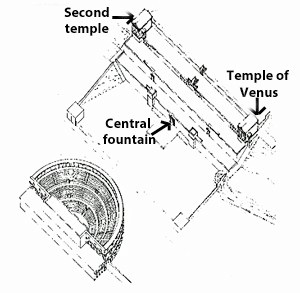
Reconstruction of part of the sanctuary at Villa Fidelia in the imperial period
Adapted from Camerieri and Manconi (referenced below, 2010, Figure 15)
With kind permission of the authors
As noted above, the temple at the east end of the terrace was dedicated to Venus soon after colonisation and rebuilt on the same site in ca. 27 BC as part of the of the theatre/ temple complex. I suggested above that it might have been explicitly linked to Venus Genetrix, at least from the time of this rebuilding. As Simone Sisani (referenced below, 2012, at pp. 436-7) pointed out:
-
“[This would have] represented, above all, the entry into the religious heart of the [Valle Umbra] of the dynastic Caesarian cult of Venus Genetrix, which was central to Octavian’s religious ideology, at least until ... after his victory at Actium ...” (my translation).
The strong symmetry that characterises this complex makes it almost certain that there was a ‘twin’ temple at the west end of the terrace. In the sections above, I addressed the possibility that this temple had been dedicated to Jupiter or alternatively to Minerva, concluding that neither of these suggestions could be supported by surviving evidence. I would now like to suggest that it might have been dedicated to divus Julius. This can be no more than a matter for speculation: Mars, for example, would also have been a logical ‘partner’ for Venus. However, it would be pleasing to think that Augustus found both the physical and political space at Hispellum to build a sanctuary to the cults of his divine ancestors (a bold architectural and political statement that would have been difficult to achieve in Rome).
The sections below present what I see as the circumstantial evidence for this suggestion.
Likely Dedication of the Complex: Evidence from Rome
We can form a view of the likely dedications of the twin temples at Villa Fidelia by considering Augustus’ comparable projects at Rome. His biography contains some relevant information:
-
“On my own land, I built the temple of Mars Ultor and the Augustan Forum from the spoils of war. On land purchased for the most part from private owners, I built the theatre near the temple of Apollo that was to bear the name of my son-in‑law, Marcus Marcellus. From the spoils of war, I consecrated offerings on the Capitol and in the temples of the divine Julius, of Apollo, of Vesta, and of Mars Ultor, which cost me about 100,000,000 sesterces” (‘Res Gestae Divi Augusti’, 4:21).
In addition, as discussed below, Cassius Dio recorded that, immediately after the triple triumph of 29 BC:
-
“The shrine of [divus] Julius ... was consecrated ... [and some of the spoils of war in Egypt] were placed in it ...”, (‘Roman History’, 51: 22).
Much of this euergetism revolved around cults associated with Augustus:
-
✴Mars Ultor, the god who had helped him to avenge the murder of Caesar;
-
✴Apollo, the god who had brought him victory at Actium; and
-
✴divus Julius, the god from whom he claimed descent.
This mindset would have been entirely consistent with a dedication of the new theatre/ temple complex at Hispellum (which had also probably been financed by the spoils of war) to the divine ancestors of Octavian/ Augustus.
Temple of Venus Genetrix at Rome
Julius Caesar, the adoptive father of Octavian, claimed Venus Genetrix as his divine ancestor. His adherence to her cult took physical shape in the temple that he built for her in Rome:
-
✴Appian recorded that Caesar had vowed this temple before the Battle of Pharsalus (48 BC), which was to be the decisive battle in his civil war against Pompey the Great:
-
“[Caesar] erected the temple to Venus [Genetrix], his ancestress, as he had vowed to do when he was about to begin the Battle of Pharsalus, and he laid out ground around the temple ... [as] a forum for the Roman people ... . He placed a beautiful image of Cleopatra by the side of the goddess, which stands there to this day” (‘Civil Wars’, 2:102).
-
✴Cassius Dio recorded that,:
-
“... after completing this new forum and the temple to Venus, as the founder of his family, he dedicated them [on the last day of his four consecutive triumphs of 46 BC], and in their honour instituted many contests of all kinds. ” (‘Roman History’, 43: 22).
An entry in the in the Augustan ‘Fasti’ records that the temple was dedicated on 26th September, from which we might reasonably assume that the ludi Veneris Genitricis were first held on 26th September 46 BC. It was at these games in 44 BC, which the young Octavian held as funerary games for his recently-murdered ‘father’, that a comet appeared in the daytime sky. As he apparently recorded in his memoirs:
-
“During the very time of these games of mine, a hairy star was seen for 7 days, in the part of the heavens that is under the Great Bear. ... The common people supposed the star to indicate that the soul of Caesar had been admitted among the immortal Gods; [and thus] the star was placed on the bust [of Caesar] that had been lately consecrated in the forum” (reproduced by Pliny the Elder, ‘Natural History’, 2:23).
Temple of Divus Julius at Rome
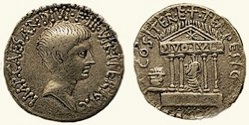
IMP CAESAR DIVI F III·VIR ITER R P C/ DIVO IVL - COS ITER ET TER DESIG (RRC 540/1, 36 BC)
Coin representing the Temple of Divus Julius in Rome, which Octavian consecrated in 29 BC
As noted above, Cassius Dio recorded that:
-
“... on the first day of [42 BC, the triumvirs, Octavian, Mark Antony and Lepidus, inter alia] ... laid the foundation of a shrine to [Julius Caesar], as hero, [i.e. of the Temple of Divus Julius] in the forum, on the spot where his body had been burned” (‘Roman History’, 47: 18).
According to Darryl Phillips (referenced below, at p. 376):
-
“A coin series of 36 BC [RRC 540/1 and 540/2, issued at the time of Octavian’s victory at Naulochus, illustrated above] provides our first glimpse of the structure [of this temple] and may mark the commencement of construction.”
The obverse designs that featured the Temple of Divus Julius, clearly identified as such by the words “DIVO IVL” on the architrave:
-
✴a cult statue stands between the temple columns; and
-
✴the sidus Iulium, the comet that had proclaimed his apotheosis during the Ludi Veneris Genitricis of 44 BC, is represented in the pediment.
The altar to divus Julius that had been erected on the site in the forum in 44 BC to mark the site of his cremation is shown to the left of the planned temple.
Cassius Dio recorded that, after Octavian’s victory at Actium in 31 BC:
-
“... the Romans at home had passed many resolutions in honour of [his] naval victory. ... [Among these], they decreed that the foundation of the shrine of [divus] Julius should be adorned with the beaks of the captured ships” (‘Roman History’, 51: 19).
He also noted that, immediately after Octavian’s triple triumph of 29 BC :
-
“The shrine of [divus] Julius ... was consecrated at this time [and some of the spoils of war in Egypt] were placed in it ...”, (‘Roman History’, 51: 22).
Thus it seems that the Temple of Divus Julius served as one of the loci for the celebration of Octavian’s victories and, although it had long been planned, it was essentially built using the spoils of war.
Darryl Phillips (referenced below, at p. 382) noted the similarities between the nearby Temple of Divus Julius and the Temple of Venus Genetrix:
-
“The Temple of Divus Julius was characterised by close-set columns. This pycnostyle arrangement was unusual in Rome; [for example,] Vitruvius names only the Temple of Divus Julius and Caesar's temple to Venus Genetrix as examples of this style in the city [in his ‘Ten Books on Architecture’, 3.3.2]. Furthermore, just as Caesar had dedicated the Temple of Venus Genetrix in connection with the celebration of his triumph in 46 BC, in similar fashion Octavian dedicated the Temple of Divus Julius on August 18, 29 BC, immediately following the celebration of his own triple triumph.”
Cult of Divus Julius in Umbria and Northern Etruria
Evidence from the Perusine War
It is possible that the cult of divus Julius had first been established in the vicinity of Hispellum at the time of the Perusine War (41-40 BC). For example, Stefan Weinstock (referenced below, at p. 407, note 6) suggested that the presence of this cult at Perusia could be:
-
“... inferred from the altar of divus Julius at which Octavian killed Roman senators and knights in 40 BC.”
These alleged human sacrifices were recorded by two surviving sources:
-
✴Cassius Dio:
-
“...most of the senators and knights [taken prisoner in Perusia] were put to death. And the story goes that they did not merely suffer death in an ordinary form, but were led to the altar consecrated to [divus Julius] and 300 knights and many senators were sacrificed there” (‘Roman History’, 48:14).
-
✴Suetonius:
-
“After the capture of Perusia, [Octavian] took vengeance on many, meeting all attempts to beg for pardon or to make excuses with the one reply: ‘You must die’. Some write that 300 men of both orders were selected from the prisoners of war and sacrificed on the Ides of March, like so many victims, at the altar raised to the deified Julius” (‘Life of Augustus’ 15:1).
These two accounts differ in some details, which led Dominique Briquel (referenced below, at p. 42) to conclude that their respective authors:
-
“... had a common source, which they summarised differently” (my translation).
It is noteworthy that neither author had full confidence in this putative source, as evidenced by the phrases: ‘and the story goes that’ (Cassius Dio); and ‘some write that’ (Suetonius).
How likely is it that these accounts of human sacrifice at an altar of divus Julius were actually true? Many scholars have agreed with Ronald Syme (referenced below, at p. 211), who believed that, while there had certainly been executions at Perusia:
-
“These judicial murders were [subsequently] magnified by defamation and credulity into a hecatomb [mass sacrifice] of 300 Roman senators and knights in solemn and religious ceremony on the Ides of March before an altar dedicated to divus Julius.”
However, one should not underestimate the amount of vitriol that was unleashed at this time:
-
✴Octavian certainly portrayed the Perusine Waras one of vengeance for the assassination of Caesar. It is clear that his army also saw it in that way: famously, two of the 48 sling shots recovered from the site (CIL XI 6721, numbers 45 and 46 in this entry in the EAGLE database) that were fired by Legio XI were inscribed: “div(om) Iul(ium)”.
-
✴Appian reported that the councillors of Perusia were all executed:
-
“... except Lucius Aemilius, who had:
-
-sat as a judge at Rome in the trial [in absentia] of the murderers of [Julius] Caesar;
-
-voted openly for their condemnation; and
-
-advised all the other [judges] to do the same, in order to expiate the guilt [presumably with the blood of the convicted assassins, should they be captured]” (‘Civil Wars’, 5:48).
-
✴Cassius Dio recorded that the men who were allegedly sacrificed on the altar of divus Julius included:
-
“... Tiberius Cannutius, [despite the fact that], during his tribuneship, he had assembled the [Roman] populace for [Octavian against Mark Antony]” (‘Roman History’, 48:14).
-
Cannutius’ actions at this assembly on behalf of Octavian had taken place in November 44 BC. However, one wonders whether he had been among the tribunes who had prevented Octavian from exhibiting Caesar’s golden chair and his crown at the theatre earlier in that year? This is at least possible and, if so, he might have paid with his life for this denial of one of the divine honours that had been conferred upon Caesar before he died.
In the light of this atmosphere of vengeance, some scholars have perceived at least an element of truth in the accounts of human sacrifice at the altar of divus Julius. Thus:
-
✴James Smith Reid (referenced below, search on ‘dragged’):
-
“If mock sacrifice [of at least some of the Roman prisoners at Perusia] really took place, it was [probably] the work [of Octavian’s soldiers ..., who may have dragged victims before the altar of Caesar. Their ardent desire to avenge him is attested by some of the sling bullets discovered on the site, ... [which] were ... inscribed ‘divom Iulium’.”
-
✴Stefan Weinstock (referenced below, at pp. 398-9):
-
“After the surrender [at Perusia, Octavian] slaughtered many senators and knights, but certainly not as many as 300, at the altar of divus Julius on 15th March 40 BC”.
-
Weinstock then set out series of historical precedents that demonstrated, to his satisfaction, that:
-
“... the alleged human sacrifice at Perusia would not have been an isolated incident.”
-
✴Jonathan Warner (referenced below, at pp. 8-9):
-
“In a final assessment, the agreement of Suetonius and Dio, ... suggests that some form of human sacrifice took place at the fall of Perusia. ... Given the likelihood that this extraordinary event happened, it has some important implications for our understanding of Roman culture and history. The elements of human sacrifice found in Roman myths and rituals suggest, for example, that the practice was not completely alien. Moreover, the ordeal and stress of civil war makes human sacrifice plausible as an act of vengeance and pietas [i.e. in order to extract the vengeance owed to Julius Caesar]. Octavian’s human sacrifice was not simply a barbaric act of impiety. Rather, it speaks to the complexity of Roman religion, a system that, at times, could rationalise extremely violent acts.”
-
✴Zsuzsanna Várhelyi, referenced below, p. 137):
-
“Syme [as quoted above] thought that these were primarily judicial murders, which the anti-[Octavian] propaganda enlarged into a sacrificial scene. While that judicial aspect was likely present as a possible interpretation of events, to my mind the parallel between these post-siege murders and the divine references on the sling bullets [see above] suggests that a religious interpretation of the conflict should also be considered as a context in which to read this horrible event.”
Whatever the truth, the allegation that Octavian had engaged in human sacrifice was certainly widely believed and long-remembered. Thus, when Seneca the Younger wrote for the young Emperor Nero in ca. 50 AD, he observed that the characteristic clemency of Octavian/ Augustus had developed:
-
“ ... only after the sea at Actium had been stained with Roman blood [in 31 BC], only after both his own and his enemy’s fleets had been shattered off Sicily [in 36 BC], only after the arae Perusinae [altars of Perugia in 41 BC] and the proscriptions [of 43 BC]” (‘de Clementia’, 1:11; slightly adapted from the translation by Zsuzsanna Várhelyi, referenced below).
Thus, even after a century or more, the horror of these allegations could be invoked in only two words: ‘arae Perusinae’.
If one accepts that these judicial murders might well have taken place at an altar to divus Julius, then one has to ask how likely it is this this altar was at the anti-Octavian city of Perusia. It could, of course, have been erected in a military camp used by Octavian’s soldiers outside the walls of the besieged city. However, once the siege was over, Octavian might well have established more comfortable quarters at the nearby colony of Hispellum, and it is possible that the prisoners were taken there for trial. That opens up the possibility that the newly settled veterans there had erected an altar to divus Julius, perhaps at the sanctuary at Villa Fidelia, and that this altar was replaced by the temple at the west end of the terrace in 27 BC.
It is interesting, in this context to note that a (now lost) inscription(CIL XI 5936, 27 BC - 14 AD) from an unknown location at Città di Castello (discussed in mu page on Colonia Julia Hispellum) commemorates Caius Fadius, a centurion of legio XI and member of the Lemonia tribe, which indicates that he had been settled on land that belonged to Hispellum. Enrico Zuddas and Maria Carla Spadoni (referenced below, p. 60) pointed out that graffiti on slingshots that survive from the Perusine War (mentioned above) indicate that legio XI fought in this conflict. However, Fadius is unlikely to have been retired at the end of this conflict, when Octavian needed to keep his legions in tact. Laurence Keppie (referenced below, at p. 77 and p. 79) recorded that veterans of legio XI were settled at Ateste in northeastern Italy after Actium: it is therefore possible that other veterans of the legion could have been settled at Hispellum at this point.
Evidence from the Sanctuary at Campo della Fiera, outside Orvieto
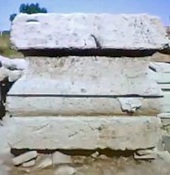
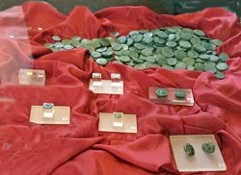
Tufa altar in front of Temple A Coins from the thesaurus near the tufa altar
Campo della Fiera Museo Archeologico, Orvieto
A small temple (identified by the excavators at Temple A) on this site and its sacred area were restored in the triumviral period. Samuele Ranucci (referenced below, 2009 and 2011) reported the details of the discovery in 2008 of a thesaurus (a stone container with an opening in its lid, often used for the collection of coins) that was found in tact here: more specifically was near a monolithic tufa altar(illustrated on the left above) in the sacred area front to the temple. A thick layer of ash and coals from sacrifices that rested against the altar covered part of its lid, including the hole through which coins were inserted. Ranucci established that the coins had been deposited the thesaurus in two distinct ceremonies:
-
✴one after ca. 38 BC, evidenced by the inclusion of 9 divus Julius bronzes from this period among the ritually-deposited coins in the lower stratum; and
-
✴a second dating to ca. 15 BC, as evidenced by ten asses of this period that had been deposited in the thesaurus just prior to a sacrifice that rendered it effectively unusable.
Six coins were subsequently pushed under the lid of the thesaurus, despite the difficulty that this entailed.
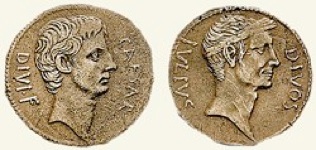
CAESAR DIVI·F/ DIVOS IVLIVS (RRC 535/1)
What interests us here is presence of the 18 divus Julius bronzes in the thesaurus:
-
✴nine in the ritually deposited layer at the bottom of the thesaurus, as mentioned above;
-
✴eight among the coins that were deposited subsequently, but before the slot in the lid was blocked; and
-
✴one among the six coins that had been pushed under the lid after the slot had become unusable.
Given their preponderance, it seems likely that these bronzes had particular significance, presumably because of their iconography, which asserted Octavian’s descent from the deified Julius Caesar.
Coins with this iconography appeared in a number of issues in the short period between the Perusine War and the Battle of Naulochus:
-
✴Coins using this type were minted for the first time by Ti Sempronius Gracchus and Q. Voconius Vitulus in 40 BC, shortly after Octavian’s victory in the Perusine War.
-
✴The iconography made its second appearance in the coins from military mints in 38-7 BC, the period that witnessed the naval battles against Sextus Pompeius and revolts at Rome and in Etruria. These issues comprised:
-
•three by Agrippa as consul designate in 38 BC (RRE 534/1, 534/2 and 534/3); and
-
•two by Octavian at about this time (RRC 535/1 and 535/2), the first of which was represented in the thesaurus.
-
✴The iconography was used again in the military issue of 36 BC (RRC 540/1 and 540/2), at the time of the victory at Naulochus (discussed above in the context of the Temple of Divus Julius in Rome).
It is surely significant that coins from only one of the five issues from military mints - RRC 535/1, 38-7 BC- were found in the thesaurus, and some if not all of these were ‘imitations’: presumably this issue was replicated locally in order to pay the soldiers who were fighting in Etruria at about this time. The precise date of the official issue (and of the closely-related RRC 535/2) is still debated. Luis Amela Valverde (referenced below, at pp. 34-5) pointed out that they do not identify Octavian as a triumvir: he therefore proposed a date between December 38 BC (when the triumvirs’ first five year term ended) and the summer of 37 BC (when the second five year term was ratified and probably backdated to the start of the year). It is, of course, possible that the ‘imitations’ found in the thesaurus were minted at a slightly later date.
Of particular importance for the present discussion is that nine of these eighteen bronzes were among the ritually-deposited layer at the bottom of the thesaurus. Samuele Ranucci (referenced below, 2009, at pp. 124) put forward two hypotheses for the date of this ritual deposition:
-
✴it might have taken place soon after the minting of these divus Julius bronzes, perhaps in atonement for an act of sacrilege at the sanctuary during the preceding hostilities; or
-
✴since the bronzes were moderately worn (and since similar bronzes were used for votive purposes throughout the Julio-Claudian period), it might have taken place at a later date (albeit that this must been prior to ca. 15 BC, when the thesaurus ceased to be used).
Ranucci himself favoured the second hypothesis. However, I think that the fact that all the bronzes belonged to a single issue, and thus (as noted above) had probably been minted locally for soldiers engaged in suppressing the revolt in Etruria, argues in favour of the first. I would like to suggest that the ritual deposition occurred during a ceremony at Temple A that celebrated Octavian’s victory at Naulochus (September, 36 BC) and the end of the Etruscan revolt.
Samuele Ranucci (referenced below, 2011, at p. 957) he observed that:
-
“Many aspects of the function of thesauri in sanctuaries still need to be clarified ... [However], one piece [of evidence] in particular comes to mind, from the ‘Commentarii of Fratres Arvales’:
-
... item foras ad aram reversi thesauros dederunt
-
It has been argued [that this] could describe, as late of the beginning of the 3rd century AD, the practice of giving thesauri [or the coins offered in them] to the altar. The relationship between the altar and thesaurus is particularly evident at Volsinii.”
I wonder whether the ceremony posited above, in which coins including nine divus Julius bronzes were among other older coins that were ritually deposited in a thesaurus next to the altar, was associated with the re-dedication of this altar itself to divus Julius. It is perhaps significant in this context that the coins RRC 540/1 and 540/2 from 36 BC (discussed above, and one of the issues that was NOT represented in the thesaurus) had obverse designs that featured the Temple of Divus Julius in Rome. David Sear (referenced below, at p. 192), whose book is an invaluable source on the coinage of the period, observed that:
-
“The bearded Octavian makes his final appearance [in these coins]. With the defeat of the last Pompeians [whose army included the last of the erstwhile adherents of Caesar’s assassins, Octavian] reverted to being clean-shaven, a sure sign that [Caesar’s murder] had at last been avenged ...”
The putative re-dedication of the altar in front of Temple A to divus Julius might have been another expression of the exaltation that followed the victory at Naulochus, which would have been shared by both Octavian and his army.
Evidence from Asisium
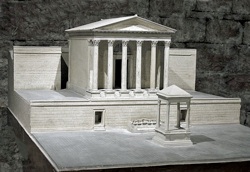
Reconstruction of the so-called Temple of Minerva (Museo Civico, Assisi)
A reconstructed inscription (CIL XI 5378, 40-20 BC) records that the so-called Temple of Minerva at Asisium was built by two brothers, Cnaeus Caesius Tiro and Titus Caesius Priscus, both of whom were serving or had served the municipium as quattuorviri quniquennales. The brothers had probably moved to Asisium from Campania, presumably as part of a programme designed to place supporters of Octavian/ Augustus in key municipal positions in the Valle Umbra.
According to John Stamper (referenced below, at p. 242, note 47), the plan of the brothers’ temple, which he dated to the period 28-15 BC, was similar to that of the Temple of Divus Julius at Rome:
-
“Both had a single cella with walls framed by corner pilasters that extended as antae into the first bay of the pronaos. Both had six columns across the front, although the pronaos [at Asisium] was shallower, two bays instead of three. Both had a high podium with lateral stairs and, in both cases, stairs leading to the podium penetrated the intercolumniations. The [temple at Asisium] was, in all likelihood, an imitation of the Temple of Divus Julius, the latter being an important paradigm for numerous Augustan temples from this period.”
In "I Quattro Libri dell Architettura" (translated by Robert Tavernor and Richard Scchofield, referenced below, at p. 315), Palladio commented on the unusual fact that the columns of the temple at Assisi rest on pedestals: the reconstruction of the elevation of the Temple of Divus Julius in Rome reproduced by John Stamper (referenced below, at p. 109) suggests that this was another feature shared by both temples. We do not know the dedication of the temple at Asisium, but it seems that the Caesii brothers adopted many features of the design of Octavian’s Temple of Divus Julius at Rome, presumably as a means of demonstrating their allegiance to him and of celebrating his recent triumphs.
Coins After Actium
Larry Kreitzer (referenced below, at p. 31) asserted that, after his victory at Actium:
-
“Octavian ... proudly proclaimed his victory on the major propaganda tool at his disposal, that of coinage. For example, a set of six denarii issued in ca. 30 BC proclaimed the peace brought about by the victory at Actium ... .”
These denarii, which were minted in an unknown mint, fall into three pairs, each of which is associated with a particular goddess:
-
Venus:
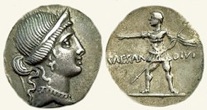
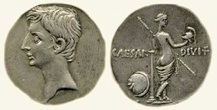
- / CAESAR DIVI F (RIC I Aug 251) - / CAESAR DIVI F (RIC I Aug 250B)
-
Victory:
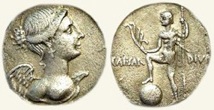
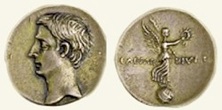
- / CAESAR DIVI F (RIC I Aug 256) - / CAESAR DIVI F (RIC I Aug 255)
-
Pax:
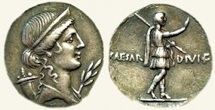
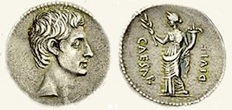
- / CAESAR DIVI F (RIC I Aug 253) - / CAESAR DIVI F (RIC I Aug 252)
The coins on the left all have the bust of a goddess on the obverse, with reverse depicting (respectively):
-
✴Venus wearing diadem and necklace, with Octavian apparently exhorting his troops before the battle;
-
✴Victory (with wings), with Octavian apparently victorious and with one foot on a globe; and
-
✴Pax wearing diadem (with cornucopia and olive branch), with Octavian apparently leading his troops into the brave new world of peace and prosperity.
The coins on the right all depict the bareheaded Octavian on the obverse, with reverse depicting (respectively):
-
✴Venus in front of a column, holding a spear and a helmet, with a shield depicting a star behind;
-
✴Victory standing on a globe, holding a wreath and a palm; and
-
✴Pax holding a cornucopia and an olive branch.
Cult of Fortuna at Villa Fidelia ?
In two consecutive paragraphs in his autobiography (‘Res Gestae’, 11-12), Augustus recorded that:
-
✴“The Senate consecrated in honour of my return [to Rome] the Ara Fortunae Reducis (altar to Fortuna Redux) at the Porta Capena, near the temple of Honour and Virtue: [the Senate]:
-
•ordered the pontiffs and the Vestal virgins to perform a yearly sacrifice [on this altar] on the anniversary of the day on which I returned to the city from Syria, in the consulship of Quintus Lucretius and Marcus Vinucius [i.e.in 19 BC], and
-
•named the day the Augustalia, after my cognomen.”
-
✴“When I returned from Spain and Gaul, in the consulship of Tiberius Nero and Publius Quintilius [i.e.in 13 BC], after successful operations in those provinces, the Senate voted in honour of my return the consecration of an altar to Pax Augusta in the Campus Martius, and on this altar it ordered the magistrates and priests and Vestal virgins to make annual sacrifice.”
He related these two missions in another paragraph (‘Res Gestae’, 29): I have reversed the order of the sentences here to put the events in chronological order:
-
“I compelled the Parthians to restore to me the spoils and standards of three Roman armies [in 20 BC], and to seek as suppliants the friendship of the Roman people. These standards I deposited in the inner shrine of the Temple of Mars Ultor. From Spain, Gaul and the Dalmatians [in 16-13 BC], after conquering the enemy, I [also] recovered, many military standards that had been lost by other generals.”
Darius Arya (referenced below, at p. 295) observed that:
-
“Noting the consecutive accounts of the altars in the Res Gestae 11-12, clearly the related structures [the Ara Fortunae Reducis and the Ara Pacis Augustae] were intended to honour [Augustus], instead of a triumph, for his efforts abroad. The two new cults are similar in that they were both decreed by the Senate upon [his] return to Rome, both in the form of an altar, and both honoured by an annual sacrifice on the anniversary of his returns, each time involving the Vestal Virgins.”
As discussed above, the second ceremony involving sacrifices related to the thesaurus in the sacred area of Temple A at Campo della Fiera roughly coincided with the second of these events. It is therefore worth discussing their possible significance in more detail, in order to understand the wider context of Augustus’ propaganda programme.
Ara Fortunae Reducis
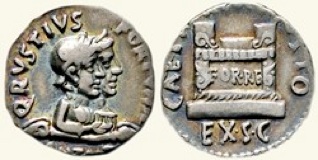
Q RVSTIVS FORTVNAE ANTIAT/ CAESARI AVGVSTO EX SC (altar inscribed) ‘FOR RE’ (RIC 1: 322)
In 22 BC Augustus had left Rome from Porta Capena, en route for Antium, the port from which he set sail for the east. Cassius Dio recorded that, during that mission:
-
“ ... Phraates [IV of Parthia], fearing that Augustus would lead an expedition against him ... sent back to him the standards and all the captives [that the Parthians had captured when they had defeated Crassus in 53 BC] ... Augustus received them as if he had conquered the Parthians in a war; for he took great pride in the achievement, declaring that he had recovered without a struggle what had formerly been lost in battle. Indeed, in honour of this, he commanded that sacrifices be decreed and likewise a temple to Mars Ultor on the Capitol ... in which to dedicate the standards; and he himself carried out both decrees. Moreover he rode into the city on horseback and was honoured with a triumphal arch” (‘Civil Wars’, 54:8).
The inscribed fasti record that: at least from the time of Augustus’ death, the Augustalia was celebrated on 12th October (which must, therefore, have been the date of his return to Rome in 19 BC); and that the altar was dedicated on 15th December, presumably also in 19 BC. John Scheid (referenced below, at p. 289) suggested that the annual sacrifices at the altar on 12th October were only formally designated as the Augustalia after Augustus’ death: nevertheless, they marked an important point in the evolution of the imperial cult.
The coin (RIC 1: 322) illustrated above depicts this altar on the reverse, identified ‘FOR[tunae] RE(duci)’. The obverse depicts jugate busts of the Fortunae Antiates, the oracles of Antium : these show two versions of Fortuna: one wearing military dress, including a helmet; and one with her braided hair decorated with a diadem. These forms are conventionally referred to as Fortuna Victrix and Fortuna Felix. The original half-length figures were kept in a fericulum (litter), represented in the coin by a bar with rams heads at each end, so that they could be moved about the sanctuary in processions. The obverse legend identifies the moneyer Quintus Rustius, who probably came from Antium. We know of at least two connections between Augustus and Antium:
-
✴in 44 BC, while still Octavian, the sanctuary here was one of four from which he had: “borrowed money, promising to return it with thanks”, as noted above; and
-
✴this was the port from which he would have left Italy in 22 BC and to which he would have returned in 19 BC.
It is tempting to think that he had promised the altar in 22 BC, in expiation of the sacrilege of 44 BC, and that the Senate assumed the obligation in recognition of the part the placated goddess had played in the recovery of the Parthian standards.
There is however nothing in the literary sources to link the altar and the annual sacrifices on the one hand and the quasi-triumph of the recovery of the standards on the other:
-
✴Augustus himself (above) simply said that the Senate had decreed the altar in honour of his return.
-
✴Cassius Dio, following an account of how Augustus had had to deal with an outbreak of civil unrest as he was returning to Rome, recorded that:
-
“For this and other things he had done while absent from the city, many honours of all sorts were voted him, none of which he would accept, save the founding of the Ara Fortunae Reducis ... and the provision that the day on which have arrived should be numbered among the holidays and be called Augustalia” (‘Civil Wars’, 54:10).
Cassius Dio did not specify the recovery of the Parthian standards among the things that Augustus had done in the east. However:
-
✴There is numismatic evidence to this effect:
-
•A coin (RIC 1: 321) in the British Museum (illustrated in the OCRE database - see the RIC link), which was also minted by Quintus Rustius, depicts the Fortunae Antiates on the obverse while, on the reverse, the goddess Victoria places as shield inscribed SC (i.e. an honorary shield which was voted by the Senate) on a cippus.
-
•A series of coins (RIC 1: 53 A-B and 54 A-B) from Colonia Patricia (modern Cordoba), depict Augustus on the obverse, wearing the laurel crown of a triumphator, and an altar identified by inscription as that of Fortuna Redox on the reverse.
-
✴It is also surely significant that figures on the pediment of the Temple of Mars Ultor were probably involved a central group of deities that comprised Venus, Mars and Fortuna.
It is difficult not to conclude that the Senate’s dedication of the Ara Fortunae Reducis in commemoration of Augustus’ (diplomatic) victory over the Parthians.
An Augustan ‘Triumphal’ Project: Conclusions
In my view, the monumental theatre-temple complex at Hispellum was unlikely to have been an ‘antiquarian project’, in which the putative pre-Roman triumphal ritual of the Umbrians was restored in some way. It should rather be seen in the context of contemporary events:
-
✴the end of the civil war at the Battle of Actium;
-
✴a second wave of veteran settlement at Hispellum thereafter;
-
✴Octavian’s triple triumph of 29 BC;
-
✴his programme of public works at Rome at this time, which constituted a substantial propaganda programme that underlined his quasi-divine status;
-
✴his restoration (as Augustus) of Via Flaminia in 27 BC, almost certainly financed from the spoils of war; and
-
✴the construction of the walls of Hispellum, including the impressive Porta Venere, at about this time, again probably financed from the spoils of war.
The theatre/temple complex at Villa Fidelia was, in my view, conceived, together with with the construction of the walls at Hisepllum and of Porta Venere, as a single project. The sanctuary would have provided a locus for ceremonies associated with Augustus’ victories, and the via triumphalis probably constituted a processional route to it from Mevania that was used in this context. Its paving by the magistri/ novemviri Valetudinis (whether this coincided with its construction or was undertaken a few decades later) thus indicates the involvement of the municipium of Mevania in these putative triumphal ceremonies.
I can see no evidence for the suggestion (above) that the sanctuary was used by all of the centres that were subsequently assigned to Augustus’ Regio VI, although the possibility cannot be ruled out. It seems to me to be more likely that it was designed to serve the extended colony at Hispellum and the surrounding municipia. This joint use would have facilitated the integration of new settlers in the Valle Umbria and what survived of the local aristocracy. It might have been used by them for the veneration of Augustus’ divine ancestors (in an early phase of the development of the imperial cult).
Read more:
C. H. Lange, “The Triumph outside the City: Voices of Protest in the Middle Republic”, in:
C. H. Lange and F. J. Vervaet (Eds), “The Roman Republican Triumph: Beyond the Spectacle”, (2014) Rome, pp. 67-81
M. Ricci, “Praetores Etruriae XV Populorum: Revisione e Aggiunte all’ Opera di Bernard Liou”, Bollettino della Deputazione di Storia Patria per l’Umbria, 111:1 (2014) 5-30
D. Briquel, “Il Sacrificio dopo la Guerra di Perugia”, in
G. Bonamenti (Ed.), “Augusta Perusia: Studi Storici e Archeologici sull' Epoca del Bellum Perusinum”, (2012) Perugia, pp. 39-64
P. Camerieri and D. Manconi , “Il ‘Sacello’ di Venere a Spello: dalla Romanizzazione alla Reorganizzazione del Territorio: Spunti di Ricerca ", Rivista di Antichità, 21 (2012) 63-80
S. Sisani, “I Rapporti tra Mevania e Hispellum nel Quadro del Paesaggio Sacro della Valle Umbra”,, in
G. Della Fina (Ed.), “Il Fanum Voltumnae e i Santuari Comunitari dell’ Italia Antica”, (2012) Orvieto (pp. 409-64)
L. Agostiniani et al. (Eds), “Screhto Est: Lingua e Scrittura degli Antichi Umbri”, (2011) Città di Castello
D. A. Phillips, "The Temple of Divus Iulus and the Restoration of Legislative Assemblies under Augustus", Phoenix, 65: 3-4 (2011), 371-92
S. Ranucci, “A Stone Thesaurus with a Votive Coin Deposit Recently Found in the Sanctuary of Campo della Fiera, Orvieto (Volsinii)”, Proceedings of the XIV International Numismatic Congress, (2011) Glasgow, pp. 954-9
J. Warner, “Human Sacrifice at Perusia”, (2012), Sunoikisis Research Symposium
Zs. Várhelyi, “Political Murder and Sacrifice: from Republic to Empire,” in:
J.W. Knust and Zs. Várhelyi (Eds.), “Sacrifice in the Ancient Mediterranean: Images, Acts, Meanings”, (2011) Oxford, 125-41
P. Camerieri and D. Manconi , “Le Centuriazioni della Valle Umbra da Spoleto a Perugia”, Bollettino di Archeologia on line (2010)
E. Zuddas and M. C. Spadoni, “La Lemonia nella Valle Umbra”, in
M. Silvestrini (Ed.), “Le Tribù Romane: Atti della XVIe Rencontre sur l’ Épigraphie (Bari 8-10 ottobre 2009”, (2010) Bari, at pp. 57-64
P. Bonacci and S. Guiducci , “Hispellum: La Città e il Territorio”, (2009) Spello
G. Donadoni, “Ville e Residenze di Campagna nell' Umbria del Cinquecento”, (2009) thesis from the Università degli Studi ‘Roma Tre’
S. Ranucci, “Il Thesaurus di Campo della Fiera, Orvieto (Volsinii)”, Annali Istituto Italiano Numismatica, 55 (2009) 103-39
S. Guiducci, "Guida Turistica di Spello: Itinerari fra Storia, Arte, Natura”, (2009) Spello
J. Scheid, “Rome et les Grands Lieux de Culte d’ Italie”, in:
A. Vigourt et al. (Eds), “Pouvoir et Religion dans le Monde Romain: en Hommage à Jean-Pierre Martin”, (2006) Paris, pp. 75-88
F. Sear, “Roman Theatres: an Architectural Study”, (2006) Oxford
J. Scheid, “Augustus and Roman Religion: Continuity, Conservatism, and Innovation”, in:
K. Galinsky ((Ed.), “Cambridge Companion to the Age of Augustus”, (2005) New York, pp. 175-93
J. Stamper, "The Architecture of Roman Temples", (2005) Cambridge
L. Amela Valverde, “La Emisión Divos Iulius (RRC 535/1–2)”, Iberia, 6 (2003) 5–40
L. Baiolini, “ La Forma Urbana dell' Antica Spello”, in:
L. Quilici and S. Quilici Gigli (Eds), “Città dell' Umbria”, (2002) Rome, pp 61-120
S. Sisani, “Lucius Falius Tinia: Primo Quattuorviro del Municipio di Hispellum”, Athenaeum, 90.2 (2002) 483-505
S. Stopponi, “Da Orvieto a Perugia: Alcuni Itinerari Culturali”, Annali della Fondazione per il Museo Claudio Faina, 9 (2002) 229-65
R. Tavernor and R. Schofield (Tr.), "Andrea Palladio: the Four Books on Architecture", (2002) Cambridge, Massachusetts
F. Coarelli, "Il Rescritto di Spello e il Santuario ‘Etnico’ degli Umbri”, in:
“Umbria Cristiana: dalla Diffusione del Culto al Culto dei Santi,” Atti del XV Congresso Internazionale di Studi sull’ Alto Medioevo, (2001) Spoleto, pp. 39-52
D. Sear, “History and Coinage of the Roman Imperators 49-27 BC”, (1998) London
L. J. Kreitzer, “Striking New Images: Roman Imperial Coinage and the New Testament World”, (1996) Sheffield
D. Manconi, P. Camerieri and V. Cruciani, “Hispellum: Pianificazione Urbana e Territoriale”, in:
G. Bonamente and F. Coarelli (Eds),“Assisi e gli Umbri nell' Antichità” Assisi (1996) pp. 375-423; the section on the sanctuary is at pp. 381-92
F. Hickson, “Augustus ‘Triumphator’ : Manipulation of the Triumphal Theme in the Political Program of Augustus”, Latomus, 50:1 (1991) 124-38
P. Fontaine, “Cités et Enceintes de l'Ombrie Antique” (1990) Brussels
L. Sensi, “Nuovi Testi Epigrafici di Età Romana da Spello”, Bollettino Storico della Città di Foligno, 11 (1987) 7-38
J-P. Thuillier, “Les Édifices de Spectacle de Bolsena: Ludi et Munera”, Mélanges de l'Ecole Française de Rome: Antiquité , 99:2 (1987) 595-608
G. L. Gregori, “Amphitheatralia I”, Mélanges de l' École Française de Rome, 96 (1984) 961-85
M. Sensi and L. Sensi, “Fragmenta Hispellatis Historiae (1): Istoria della Terra di Spello, di Fausto Gentile Donnola”, Bollettino Storico della Città di Foligno, 8 (1984) 7-136
L. Keppie, “Colonisation and Veteran Settlement in Italy, 47–14 BC”, (1983) Rome
M. Brozzi, “Guida di Spello Romano”, (1972) Assisi
S. Weinstock, “Divus Julius”, (1971) Oxford
C. Pietrangeli, “Mevania”, (1953) Rome
R. Syme, “The Roman Revolution” (1939, latest edition 2002) Oxford
J. S. Reid, “Human Sacrifices at Rome and Other Notes on Roman Religion”, Journal of Roman Studies, 2 (1912) 34‑52
Ancient History: Main Page Colonia Julia Hispellum
Seviri and Seviri Augustales at Hispellum Sanctuary at Villa Fidelia after Colonisation
Sanctuary at Villa Fidelia in the 4th Century AD
Return to the page on the History of Spello.



